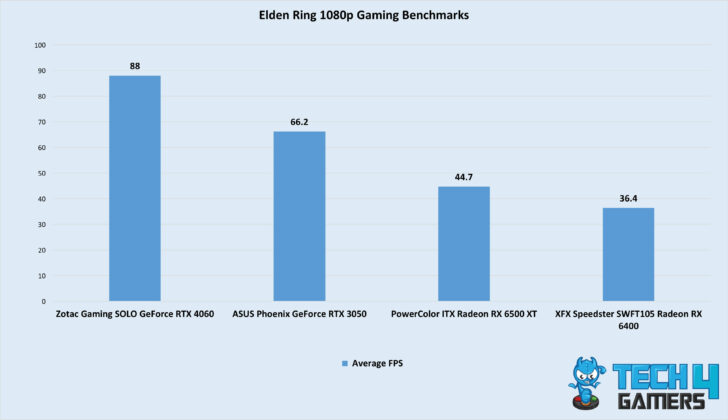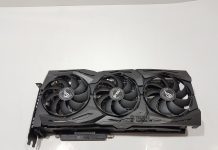A Low Profile Graphics card is the crux of a capable small form factor build, responsible for bolstering the entirety of the build into existence. With both Nvidia and AMD manufacturing low-profile GPUs, the list has culminated into an extensive selection, making it challenging to find the one that meets your requirements. My list of the Best Low Profile Graphics cards addresses precisely that, allowing you to choose from the best options available.
Take a look at my Best Low Profile GPU selection below; all compared to each other, and what their target user is:








Best Low Profile Graphics Card
Here are my picks for the Best Low Profile Graphics Card.
- ASUS Phoenix GeForce RTX 3050
- XFX Speedster SWFT105 Radeon RX 6400
- Zotac Gaming SOLO GeForce RTX 4060
- PowerColor ITX Radeon RX 6500 XT
ASUS Phoenix GeForce RTX 3050
Best Overall Low Profile GPU

Architecture: NVIDIA Ampere | CUDA Cores/SPs: 2560 | Game Clock: 1777 MHz | Boost Clock: 1807 MHz | Memory: 8GB GDDR6 | Recommended PSU: 550W | Dimensions: 177 x 128 x 51 mm | Power Connectors: 1 x 8-pin PCIe | RGB: No
Pros
Cons
Following the simple theme, ASUS has placed no RGB elements on the card, which should not be a deal-breaker. While its cooling solution is nothing to write home about, the single fan axial tech design provides sufficient cooling for the most part. Adding on to that, you also get Dual ball fan bearings, a protective backplate, and a PCB coating to prevent dust from accumulating. Its toned-down design language and smaller cooling solution have not stopped ASUS from tweaking its boost clock speeds to 1807 MHz, a 40 MHz increase over the Founders edition variant of the card.
The ASUS Phoenix GeForce RTX 3050 draws all of its power from a single 8-pin connector. Speaking of which, the card is rated at 130W, with ASUS recommending a 500W power supply to go along with the card. At its core, the Phoenix GeForce RTX 3050 bears similar specifications to other variants of the GeForce RTX 3050. Based on the Ampere architecture, the ASUS Phoenix GeForce RTX 3050 is packed with 8GB of GDDR6 memory on a 128-bit wide memory bus, a total of 2560 cuda cores, as well as third-generation tensor cores.
What Makes It The Best Overall Low Profile GPU
All in all, the ASUS Phoenix GeForce RTX 3050 achieves a balance between its price, performance, and design, boasting attributes that constitute all aspects. It has been titled the Best Overall Low Profile GPU for its relatively decent performance and a form factor that suits smaller cases.
| Performance: 9/10 | Value: 9/10 |
| Features: 9/10 | Design: 8/10 |
Related to the GeForce RTX 3050:
XFX Speedster SWFT105 Radeon RX 6400
Best Single Slot Low Profile GPU

Architecture: AMD RDNA 2 | CUDA Cores/SPs: 768 | Game Clock: 2039 MHz | Boost Clock: 2321 MHz | Memory: 4GB GDDR6 | Recommended PSU: 400W | Dimensions: 155 x 68 x 15 mm | Power Connectors: None | RGB: No
Pros
The GPU’s horsepower naturally trails behind most full-sized GPUs, which is further evidenced by the toned-down specifications. Equipped with 768 streaming processors, 12 compute units, and 4GB of GDDR6 VRAM, its classification as a budget GPU is clear. As far as clock speeds are concerned, the XFX Speedster SWFT105 RX 6400 boosts up to a speed of 2321 MHz; however, overclocking capabilities have been completely disabled.
In a market riddled with cards that have higher power consumption, the RX 6400 is a breath of fresh air thanks to its extremely low power draw of 53W. Moreover, the card doesn’t even require a power connector for operation, drawing out all of its power from the PCIe connection alone, which is almost unheard of in the modern landscape of GPUs. Furthermore, the exclusion of any additional power connectors makes it the best low profile secondary GPU.
What Makes It The Best Single Slot Low Profile GPU
Granted, the XFX Speedster SWFT105 Radeon RX 6400 is not the most powerful GPU available; it does a fantastic job holding its own against budget GPUs. While its limited memory holds it back in graphically demanding instances, it makes for the Best Single Slot Low Profile GPU thanks to its well-built single-slot design, sub-75W power consumption, and decent overall performance.
| Performance: 7/10 | Value: 8/10 |
| Features: 8/10 | Design: 9/10 |
Zotac Gaming SOLO GeForce RTX 4060
Best Performing Low Profile GPU

Architecture: NVIDIA Lovelace | CUDA Cores/SPs: 3072 | Boost Clock: 2460 MHz | Memory: 8GB GDDR6 | Recommended PSU: 500W | Dimensions: 163 x 117.6 x 39.5 mm | Power Connectors: 1 x 8-pin PCIe | RGB: No
Cons
As hinted at previously, Zotac has kept things nice and simple with the Gaming SOLO GeForce RTX 4060’s design, presenting it in a clean black finish with no signs of RGB. Naturally, the card also features a single-fan design that is accompanied by two heatsinks, which proves to be a sufficient combination. In my testing, noise levels also remained reasonably low, which is an added plus. Performance is where the Zotac Gaming SOLO GeForce RTX 4060 truly shines, outpacing most of its competition by a decent margin. It sports 3072 Cuda cores, 8 GB of GDDR6 memory, and a boost clock speed of 2460 MHz. On the other hand, power consumption is also relatively low, coming in at 115W, the same as the founder’s edition variant.
Ray tracing is also a viable option for the Zotac Gaming SOLO GeForce RTX 4060, thanks to the presence of third-generation RT cores. Its ray tracing capabilities are further accentuated with the company of DLSS 3.0, which boosts frame rates by an astounding amount thanks to Nvidia’s frame generation technology.
What Makes It The Best Performing Low Profile GPU
To sum up, the Zotac Gaming SOLO GeForce RTX 4060 is a low profile GPU done right. With 8GB of GDDR6 memory, 3072 cuda cores, and a boost clock speed of 2460 MHz, the card comes with a great host of features, making it the Best Performing Low Profile GPU. Additional features such as DLSS 3.0 and NVENC support further contribute to its overall value.
Related to the GeForce RTX 4060:
| Performance: 10/10 | Value: 8/10 |
| Features: 9/10 | Design: 8/10 |
PowerColor ITX Radeon RX 6500 XT
Best Low Profile GPU Under $200

Architecture: AMD RDNA 2 | CUDA Cores/SPs: 1024 | Game Clock: 2610 MHz | Boost Clock: 2815 MHz | Memory: 4GB GDDR6 | Recommended PSU: 400W | Dimensions: 165 x 125 x 40 mm | Power Connectors: 1 x 6-pin PCIe | RGB: No
Pros
Cons
Before anything, let’s first go over its design which has remained a lot like other low profile graphics cards on this list. PowerColor has not gone out of its way to change the card’s looks, sticking to a simple single-fan design. Speaking of which, the fan uses a dual-ball bearing structure, improving its sturdiness. While PowerColor has stretched its clock speeds to a whopping 2810 MHz, it falls slightly short in terms of its memory configuration, only coming with 4GB of GDDR6 memory, that too on a 64-bit wide bus. Naturally, that should not be a deal breaker, given its value proposition as a low profile graphics card. Furthermore, AMD has also employed 16MB of infinity cache to the card to make up for its narrow memory bandwidth.
Of course, AMD’s Fidelity FX super-resolution is also present, which, despite trailing behind DLSS for the most part, is a nice inclusion on budget graphics cards such as this one. The differences between the two upscaling methodologies are further highlighted in our detailed comparison of DLSS vs FSR.
What Makes It The Low Profile GPU Under $200
While enthusiasts have expressed their apparent disdain over RX 6500 XT’s limited memory and lack of hardware encoding, it still prevails as a low profile GPU thanks to its economical price tag and dual-slot design. That, accompanied by the lower power consumption, makes it the Best Low Profile GPU Under $200.
| Performance: 7/10 | Value: 10/10 |
| Features: 8/10 | Design: 8/10 |
Gaming Benchmarks
We tested these low profile graphics cards to check their real-world performance. Here are the results:
Important GPU Key Terms
Selecting a graphics card is an intricate process, especially for beginners that are bewildered by the plethora of terms floating around on the internet. Here is a brief explanation of some of the most commonly used GPU terms to help you make an informed decision.
- Cores: The GPU consists of several thousand processors responsible for dealing with separate tasks.
- Clock Speeds: The rated clock speed your graphics card arrives with refers to its capabilities to process instructions at a particular rate. To put it simply, higher GPU frequency allows your card to process instructions faster, improving the overall system performance.
- VRAM: Video memory or VRAM is dedicated graphics memory used to store data processed by the graphics card.
- Bus Width: Represented in bits, the Bus Width of a GPU is responsible for determining the number of pathways available for transferring data between the GPU and memory under a single cycle.
- TDP: Measured in watts, the thermal design power of a graphics card determines the amount of power required to maintain normal temperatures.
- Overclocking: Overclocking refers to the act of pushing the graphics card to higher clock speeds to achieve better performance.
How We Picked The Best Low Profile Graphics Cards
Here are a few factors we considered when selecting the Best Low Profile Graphics Card.
- Performance: Performance directly impacts your experience, especially when engaging in tasks such as gaming, video editing, and 3D rendering, all of which have certain requirement thresholds that need to be met for a smooth experience. In addition to that, going for a better-performing card will also future-proof your system.
- Cooling Performance: GPUs equipped with a subpar cooling solution run with the risk of running into thermal throttling issues, which can directly affect performance. Not only that, but high temperatures can reduce a GPU’s lifespan. To prevent that, I selected graphics cards that provide sufficient cooling, ensuring smooth operation.
- Price and Value: It is essential to ensure that the graphics card you choose falls within your budget range while also providing satisfactory results. Most of the cards on this list provide decent value, especially for low profile cards.
- Appearance: Going for a graphics card that falls dull in comparison to the rest of your build can be detrimental to the visual appearance of your entire setup. Whether you are going for a white-themed build or something else entirely, ensuring the GPU complements the rest of the build can be crucial for some people. Of course, this mostly comes down to personal preference.
Frequently Asked Questions
low profile GPUs are graphics cards specifically designed to fit inside small form factor cases.
Low profile GPUs are restricted to a maximum height of 2.536 inches, which comes in at 64.4mm.
Yes, low profile GPUs can be installed inside a desktop computer.
Thank you! Please share your positive feedback. 🔋
How could we improve this post? Please Help us. 😔
[Hardware Expert]
With a major in Computer Science, Sameed is a tech enthusiast who puts his passion for gadgets into words and creates informative blogs. From comparing different hardware to reviewing the best RAMs, motherboards, and graphics cards for your next build, Sameed has covered a wide spectrum of topics that have given him a special insight into every nook and cranny of the tech world. Sameed is also a certified expert at Computer Hardware & Networking.
Get In Touch: sameed@tech4gamers.com


 Threads
Threads










![Tried & Tested: BEST RX 7800 XT Graphics Cards [Including Benchmarks] Best RX 7800 XT Graphics Cards](https://tech4gamers.com/wp-content/uploads/2023/09/Best-RX-7800-XT-Graphics-Cards-218x150.jpg)
